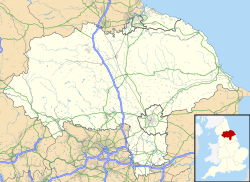| High and Low Bishopside | |
|---|---|
| Civil parish | |
 Pateley Bridge | |
Location within North Yorkshire | |
| Area | 25.72 km2 (9.93 sq mi) |
| Population | 2,210 (2011 census) [1] |
| • Density | 86/km2 (220/sq mi) |
| OS grid reference | SE175677 |
| Civil parish |
|
| Unitary authority | |
| Ceremonial county | |
| Region | |
| Country | England |
| Sovereign state | United Kingdom |
| Main settlements | Pateley Bridge, Glasshouses, Wath and Wilsill |
| Police | North Yorkshire |
| Fire | North Yorkshire |
| Ambulance | Yorkshire |
| Website | https://www.pateleybridgetowncouncil.gov.uk/ |
High and Low Bishopside is a civil parish in Nidderdale, in North Yorkshire, England. It includes the town of Pateley Bridge and the villages of Glasshouses and Wilsill, the southern part of Wath and the hamlets of Blazefield, and Fellbeck.
Contents
The parish touches Bewerley, Dacre, Eavestone, Fountains Earth, Hartwith cum Winsley, Laverton, Sawley, Stonebeck Down and Warsill. [2] In 2011 the parish had a population of 2,210. [1] There are 39 listed buildings in High and Low Bishopside. [3] The parish's council is called "Pateley Bridge Town Council". [4]
The parish is bounded on the west by the River Nidd, and includes a large area of moorland to the east of the town. The parish therefore does not include the part of the Pateley Bridge built-up area west of the Nidd in the parish of Bewerley, where Pateley Bridge post office, the Nidderdale showground, Nidderdale High School and the district of Bridgehouse Gate are located.
